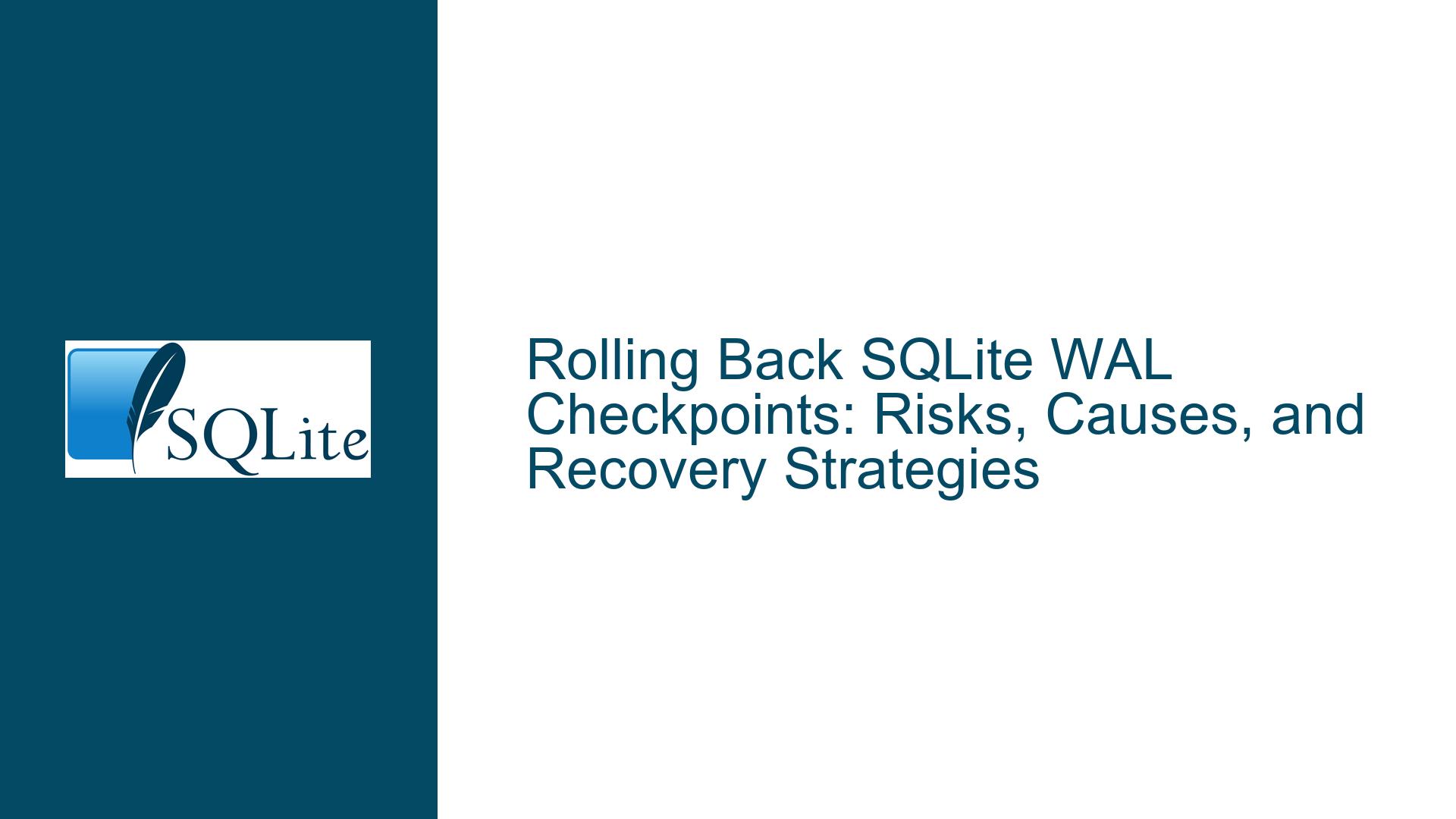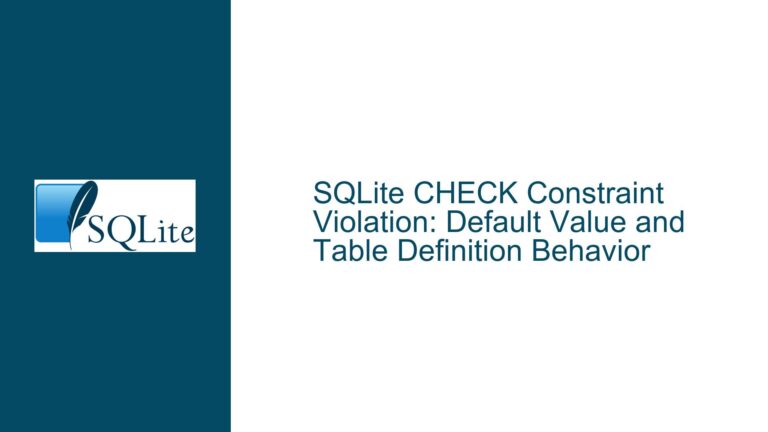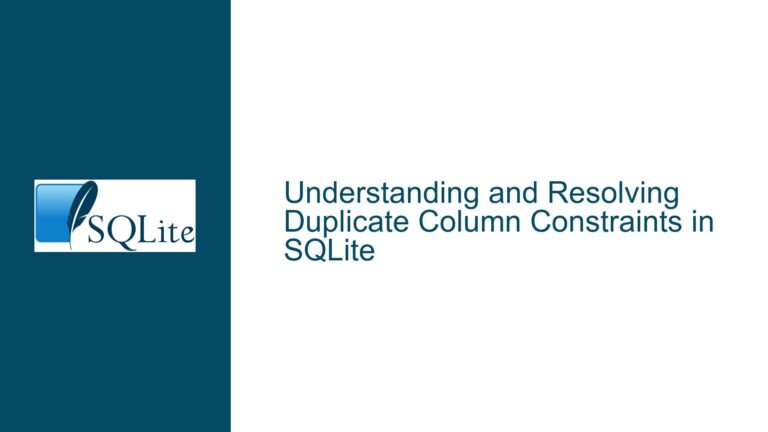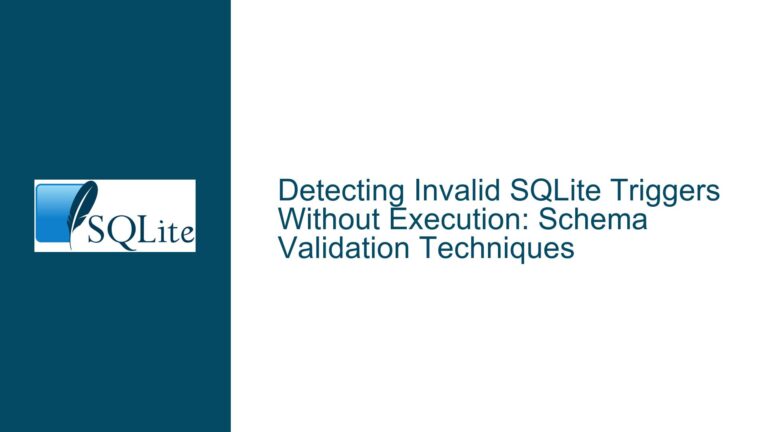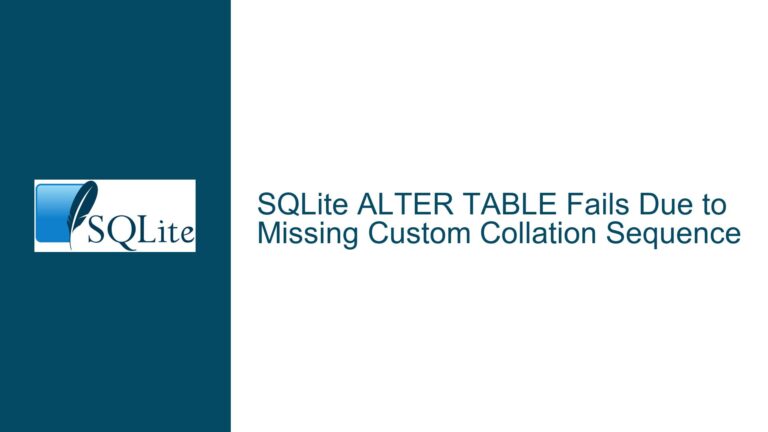Rolling Back SQLite WAL Checkpoints: Risks, Causes, and Recovery Strategies
Understanding the Challenge of Reverting WAL Checkpoint Operations
The core issue revolves around whether it is possible to reverse the effects of a Write-Ahead Logging (WAL) checkpoint in SQLite without triggering database corruption or data loss. A checkpoint operation in WAL mode transfers modifications from the WAL file to the main database file, after which the WAL is typically truncated (in TRUNCATE mode). The original proposal suggests selectively backing up database pages modified by the WAL before checkpointing, then restoring those pages to "undo" the checkpoint. While this approach seems theoretically plausible, it involves bypassing SQLite’s built-in mechanisms, raising questions about atomicity, consistency, and low-level file management.
The problem arises in distributed systems like rqlite, which rely on consensus algorithms such as Raft to manage log truncation and node synchronization. In failure scenarios, a node may need to revert to a pre-checkpoint state efficiently, especially with multi-gigabyte databases where full backups are impractical. The challenge lies in reconciling SQLite’s internal state management (e.g., shared memory, page caches) with external interventions like partial page restores or manual WAL manipulation. Key technical dependencies include the structure of the WAL file, the role of the -shm shared-memory file, and the database header (page 1), which tracks critical metadata such as the database size and WAL frame counts.
Critical Risks and Technical Limitations in Checkpoint Rollback Attempts
1. Database Corruption via Direct Page Manipulation
SQLite’s reliability stems from its ACID guarantees, which depend on strict control over database file modifications. Overwriting pages in the main database file without coordinating with SQLite’s internal state (e.g., the page cache, write-ahead log, and -shm file) risks introducing inconsistencies. For example:
- The
-shmfile contains volatile data about active WAL frames and lock states. It is never persisted to disk, meaning restoring a backup of this file is ineffective. - Connections maintain in-memory page caches that may hold outdated versions of pages modified externally. Restoring pages from a backup while connections are active could lead to cache mismatches, causing subsequent queries to return incorrect data or crash.
- The database header (page 1) includes a 4-byte "database size" field. If a checkpoint reduces the database size (e.g., by truncating unused pages), restoring older pages without updating this field could leave the database in an invalid state.
2. Undefined Behavior in Manual WAL Reconstruction
Creating a synthetic WAL file to "undo" a checkpoint requires precise adherence to SQLite’s WAL format, including frame checksums, salt values, and commit counters. Even minor discrepancies (e.g., incorrect frame offsets or mismatched salt values between the WAL and -shm file) will cause SQLite to reject the WAL during recovery. Additionally, the PRAGMA wal_checkpoint(TRUNCATE) operation resets the WAL file’s header, making it impossible to reuse the original WAL after truncation without reconstructing its entire structure.
3. Concurrency and Isolation Challenges
For systems like rqlite that manage exclusive database access, ensuring no active reads or writes during restoration is nontrivial. Even brief moments of concurrent access during page restoration could lead to torn writes or partial updates. Furthermore, SQLite’s file locking mechanisms (e.g., the -wal and -shm lock bytes) are not designed to accommodate external file modifications, potentially resulting in deadlocks or unresponsive connections.
4. Filesystem and Hardware Interactions
Directly overwriting database pages assumes that the filesystem guarantees atomic page-level writes, which is not universally true. For example, a power failure during the restoration of pages from backup could leave the database in a half-updated state. Similarly, filesystems with copy-on-write (CoW) semantics (e.g., Btrfs, ZFS) may introduce unexpected behavior when pages are modified outside SQLite’s control.
Systematic Solutions for Safe State Reversion and Incremental Backups
1. Leveraging Copy-on-Write Filesystems for Atomic Snapshots
Instead of manually backing up individual pages, use filesystem-level snapshots to capture the database state before a checkpoint. On supported filesystems (e.g., Btrfs, XFS, ZFS), a CoW snapshot can be created in milliseconds, regardless of database size:
cp --reflink=always db.sqlite db_backup.sqlite
cp --reflink=always db.sqlite-wal db_backup.sqlite-wal
This creates a space-efficient snapshot that shares unchanged data blocks with the original. To restore:
- Ensure all database connections are closed to invalidate caches and
-shmstate. - Replace the live database and WAL files with the snapshots.
- Reopen connections to rebuild the
-shmfile from the restored WAL.
2. Incremental Backup via SQLite’s sqlite_dbpage Virtual Table
The sqlite_dbpage virtual table exposes raw database pages, enabling incremental backups without direct file manipulation. Combined with the WAL’s frame data, this allows selective backup of modified pages:
-- Attach the backup database
ATTACH DATABASE 'backup.sqlite' AS backup;
-- Copy modified pages using page numbers from the WAL
INSERT INTO backup.sqlite_dbpage(page_number, data)
SELECT page_number, data FROM main.sqlite_dbpage
WHERE page_number IN (/*...WAL-derived page list...*/);
Restoration involves reversing this process, writing pages back to the main database. This method is safer than manual file edits because it operates through SQLite’s APIs, ensuring cache coherency and transactional integrity.
3. Controlled Checkpointing with Delayed WAL Truncation
Modify the checkpointing strategy to retain WAL files longer, providing a window for recovery. Instead of using TRUNCATE mode, which immediately truncates the WAL, use PASSIVE or RESTART modes to delay truncation until a later time. This allows the original WAL to remain available for recovery if a rollback is needed. To implement this:
- Disable automatic checkpoints via
PRAGMA wal_autocheckpoint=0;. - Manually invoke checkpoints with
PRAGMA wal_checkpoint(RESTART);when ready. - Retain WAL files until confirming that the checkpointed state is stable.
4. Hybrid Approach: Page-Level Backup with Transactional Isolation
If direct page backup is unavoidable, follow a strict protocol to minimize risks:
- Freeze Database Activity: Block all read/write operations, ensuring no active transactions.
- Extract Modified Page Numbers: Parse the WAL to identify pages slated for checkpointing. Tools like
sqlite3_analyzeror custom scripts can decode the WAL’s binary format. - Backup Pages: Read identified pages directly from the database file using
pread()or equivalent, ensuring no filesystem caching issues. - Checkpoint with TRUNCATE: Execute
PRAGMA wal_checkpoint(TRUNCATE);to finalize the checkpoint. - Restore Procedure:
- Close all database connections to reset caches and
-shm. - Overwrite the modified pages in the database file using
pwrite(). - Manually adjust the database size in page 1 if the checkpoint truncated the file.
- Reopen the database to rebuild the
-shmfile.
- Close all database connections to reset caches and
5. Consensus Layer Integration for State Management
In systems like rqlite, coordinate checkpointing with the Raft log’s committed entries. Treat checkpoint operations as state machine snapshots in Raft, ensuring that a checkpoint is only finalized after the corresponding log entries are irreversibly committed. If a rollback is needed, rebuild the database state by replaying Raft logs from the last confirmed checkpoint. This avoids low-level database manipulation entirely by treating SQLite as an append-only log processor.
6. Validation and Corruption Detection
After any manual intervention, validate the database using PRAGMA integrity_check; and PRAGMA quick_check;. Additionally, verify the WAL header’s magic numbers and checksums to ensure consistency. Tools like sqlite3_dbhash can generate per-page hashes for comparison against backups.
By combining these strategies, developers can achieve efficient, safe rollback capabilities without resorting to error-prone manual file edits. The optimal approach depends on the specific requirements for performance, scalability, and fault tolerance in the target system.
